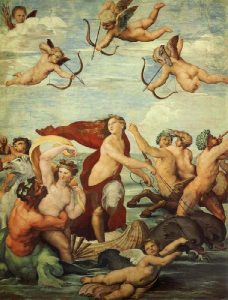Longing for what we have lost 3.2
Art and the ideal beauty
Nature and the ideal

In analysing beauty Winckelmann distinguished between ideal beauty and the kinds of beauty found in nature:
The shape of beauty is either individual–that is, confined to an imitation of one individual–or it is a selection of beautiful parts from many individuals, and their union into one, which we call ideal.[1]

For Winckelmann perfect beauty consists in the ideal, which nature cannot rival. Combining the most beautiful characteristics of natural things draws art closer to the divine and elevates it above the human. Winckelmann suggests this was the practice of the best Greek artists and modern painters, such as Raphael. A popular story in this vein is of Zeuxis, an ancient painter commissioned to paint Helen of Troy. None of the maidens could match the ideal beauty for which the artist sought, so he took different beautiful aspects from a number of them.
Winckelmann comments that Raphael tried to accomplish the use of ideals in his ‘Galatea’ but fell short with the use of a common face.
[1] Winckelmann 1764, 120 ( History of ancient art)
